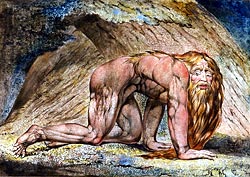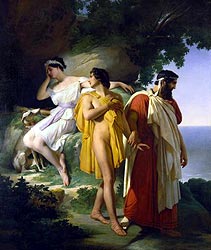|
The Book of Daniel
Although written in the first person, the author of the book of Daniel was actually a pious Jew living under the persecution of
Antiochus Epiphanes, 167-164 B.C.2 To encourage his suffering fellow believers, he tells six stories, set in earlier days in Babylon
just before and after the Persian conquest, which illustrate how faithful Jews, loyally practicing their religion, were enabled by divine
aid to triumph over their enemies. The memory of Nebuchadnezzar was still strong at the time of this writing because he had crushed
two Jewish revolts and then had destroyed the temple in Jerusalem in 586 B.C.3
Nebuchadnezzar II ruled over the Babylonian empire from 605 to 562 B.C. The city of Babylon was located in the Euphrates river in the region
of present day Iraq. The kingdom of Juda, in southern Palestine, was caught in a power struggle between the Babylonian empire and
imperial Egypt. When in 587-586 B.C. Nebuchadnezzar attacked and destroyed Jerusalem and its temple, he deported many of its inhabitants
to Babylon. During this period, known as the Babylonian Exile (586-539 B. C.), many Jews prospered economically in Babylon, and not all
continued to observe Jewish law faithfully.
William Blake
The visionary poet and artist William Blake despised the emphasis on rational thought so popular in 18th-century England. Sir Isaac
Newton's mathematic and scientific discoveries, which proved the existence of universal laws and the value of scientific reasoning,
heralded the Age of Enlightenment in Europe. Advancements in areas such as optics, chemistry, and biology encouraged intellectuals to
put their trust in nature, as understood by reason, rather than in God. Many people believed that they could rationally unlock nature's
secrets to benefit their own lives.
Blake, on the other hand, believed that imagination, not reason, was the dominant force of human nature. He rebelled against the art
establishment and created his own artistic vocabulary, often illustrating apocalyptic scenes from the Bible. His bestial images,
including his 1795 version of Nebuchadnezzar, illustrated the uncontrollable, irrational side of human beings.4 He apparently intended
this image of the mad king to be paired with an image of Newton that represented rational thought.

|
|
Roll over the image to see details from Nebuchadnezzar |
Nebuchadnezzar
In this hand-colored print Blake depicts Nebuchadnezzar as part animal and part man. The once-mighty Nebuchadnezzar crawls on his
hands and knees, and his feet sport bird's talons as described in the Book of Daniel. His golden hair, which was said to grow like an
eagle's feathers, trails down his back and over his thighs. His lengthy beard drags beneath his taut body. Nebuchadnezzar's parted lips,
furrowed brow, heavy eyelids, and especially his staring eyes all lend his face an expression of helplessness. The king's strong muscled
body, rendered in great detail, seems startlingly at odds with his mental instability.

|
|
A typical example of Neoclassical painting
Telemachus and Eucharis
Raymond Auguste Quinsac Monvoisin
1824
The Minneapolis Institute of Arts |
Nebuchadnezzar's crawling outdoors, nude, leaves no doubt of his madness. The large twisted tree trunks and foliage behind him may refer to
the large tree in his dream. The imaginative and emotional tone of Blake's stunning picture of Nebuchadnezzar relates it to works by
other artists called
ROMANTICS,
who reacted against the staid
NEOCLASSICAL
STYLE
with dramatic, often apocalyptic images. But the distinctive style of this piece, marked by strong contour lines, is uniquely Blake's.
1 The New Oxford Annotated Bible with Apocrypha, Revised Standard Version, (New York: Oxford University Press, 1977), p.
1067.
2 A ruler of the Seleucid Dynasty, whose capital was Antioch in present day
Syria.
3 The New Oxford Annotated Bible, Bruce M. Metzger and Roland E. Murphy, eds. (New York: Oxford University Press,
1994), p.1126
4 In about 1790, Blake first used this image of Nebuchadnezzar in a book he wrote and illustrated called The Marriage
of Heaven and Hell.
|











